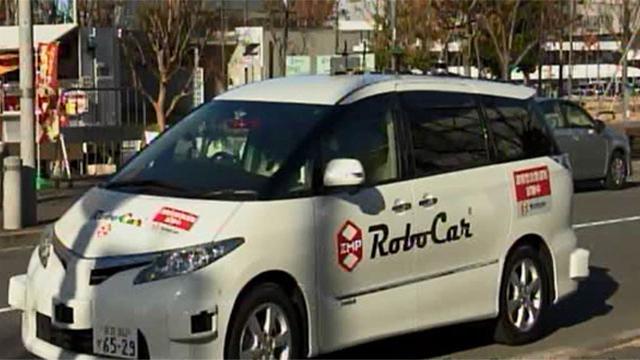The test was conducted by Tokyo-based ZMP, a firm that develops technology for automated driving.
The vehicle set out on a public road in Tokyo on December 14th, with no one in the driver's seat.
It drove at a speed of about 20 kilometers per hour and stopped after about 150 meters.
It is programmed to avoid hitting people and other vehicles that are identified by its sensors. It can be controlled remotely in emergencies.
Driverless cars have been tested in the past on private courses and at other sites. This latest test was the first to be held in Japan since the experiments on public roads became possible in June.
The firm says that by 2020, it hopes to have driverless taxis in use that can transport customers from Haneda Airport or Tokyo Station to Olympic venues. Company officials say they will continue testing to develop the technology as quickly as possible.
ZMP President Hisashi Taniguchi says no one has significant experience with completely driverless cars on public roads, so there is no telling what could happen. He says his firm will simulate a variety of scenarios to lessen unforeseen risks.
Automated vehicles being tested around the world
Some people in Japan refer to driverless vehicles as "dream cars". But the dream is fast on its way to becoming a reality in many countries.
In the United States, IT giant Google is conducting trial runs on public roads with a view to developing fully automated vehicles. Other companies are also testing cars with no one in the driver's seat.
In Japan, due to safety concerns, such tests have been restricted to roads with limited entry to pedestrians and other vehicles.
There are high hopes for automated vehicles in Japan, especially in sparsely populated areas with aging populations, and in communities that can no longer maintain bus services and other means of getting around.
In 13 hilly and mountainous areas around Japan in September, the transport ministry and private companies began testing automated vehicles as a way to transport the elderly and move supplies.
In Iinan in Shimane Prefecture, a car equipped with radar was tested on a route that included a roadside rest area and a hospital.
In Taiki in Hokkaido, an automated minibus drove on roads that were embedded with magnetic vehicle guide markers.
The government wants to make driverless transport services a reality in time for the 2020 Olympic and Paralympic Games.
The transport ministry and automakers are hoping that development will move forward now that tests are permitted on public roads.
Driverless taxis - how they work
The venture firm that conducted the experiment says it hopes automated taxis will be put into practical use by 2020. Here's how the service would work: The customer calls a taxi on a dispatch app using a smartphone or other device.
When the taxi arrives, the client holds the phone up to open the door and get in. The car drives automatically to the destination entered on the app.
The payment system is cashless. Once the fee is paid, the door opens.
Officials say the system would be easy to use for foreign tourists who do not understand Japanese.
The service will probably be limited to certain areas in 2020. But the firm says it hopes to be able to drive people on the highway from Haneda Airport or Tokyo Station to Olympic venues.
The challenge for practical use is to ensure the safety of not only the users, but also the safety of other vehicles and pedestrians.
Driverless taxis could help with societal challenges
Some taxi companies are taking part in the development of automated cars as a way to deal with the problem of aging drivers and personnel shortages.
Hinomaru Kotsu is a taxi company in Tokyo working with a firm that developed the technology for the latest test. It says the average age of its drivers is nearly 60, and that about 100 of its 1,400 drivers are 70 or older.
The firm says it will have to roll back its services in the early morning hours and other time slots if the trend continues.
Kazutaka Tomita, president of Hinomaru Kotsu, says that while some taxi companies are hostile toward self-driving vehicles, the biggest concern in the industry is the worker shortage.
He says he hopes automated cars will ultimately be helpful for taxi companies.
